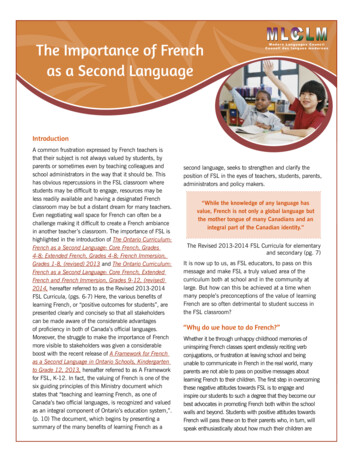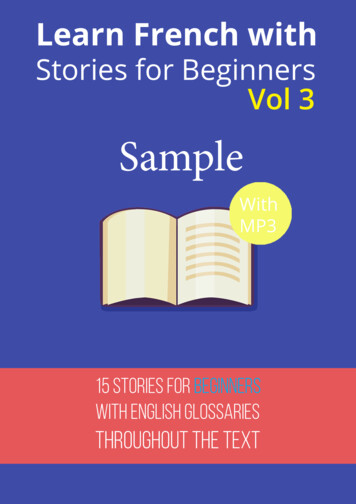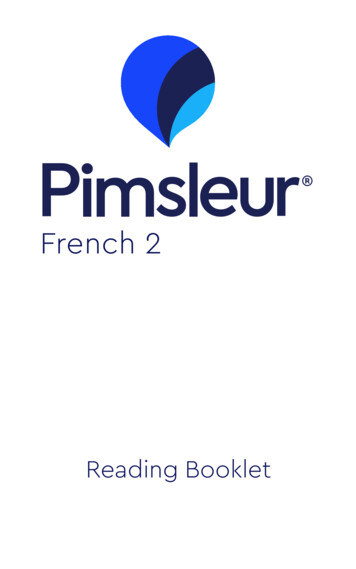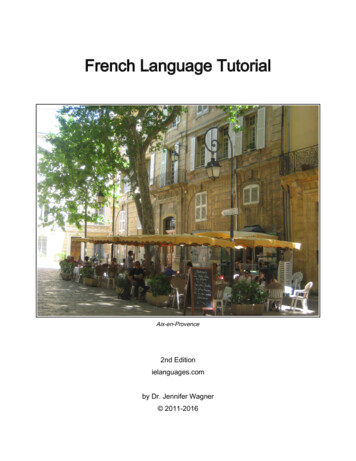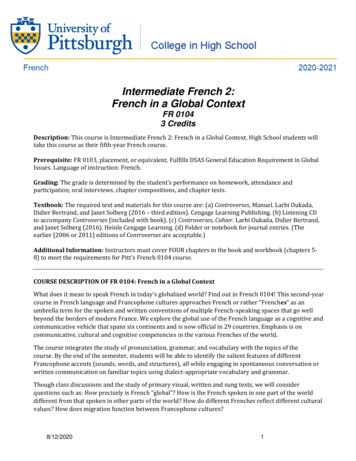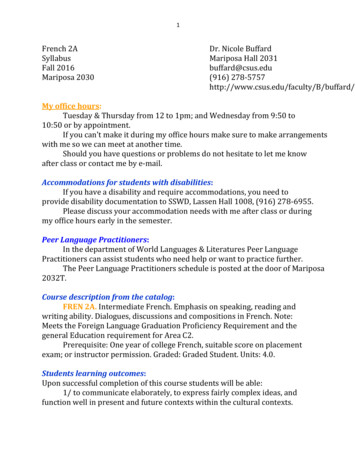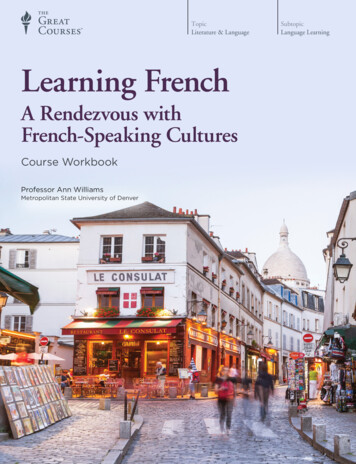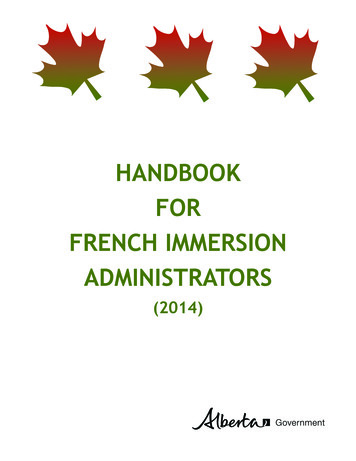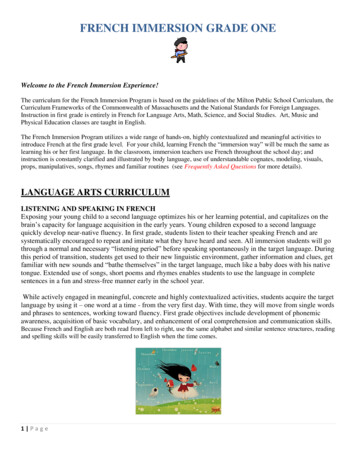
Transcription
FRENCH IMMERSION GRADE ONEWelcome to the French Immersion Experience!The curriculum for the French Immersion Program is based on the guidelines of the Milton Public School Curriculum, theCurriculum Frameworks of the Commonwealth of Massachusetts and the National Standards for Foreign Languages.Instruction in first grade is entirely in French for Language Arts, Math, Science, and Social Studies. Art, Music andPhysical Education classes are taught in English.The French Immersion Program utilizes a wide range of hands-on, highly contextualized and meaningful activities tointroduce French at the first grade level. For your child, learning French the “immersion way” will be much the same aslearning his or her first language. In the classroom, immersion teachers use French throughout the school day; andinstruction is constantly clarified and illustrated by body language, use of understandable cognates, modeling, visuals,props, manipulatives, songs, rhymes and familiar routines (see Frequently Asked Questions for more details).LANGUAGE ARTS CURRICULUMLISTENING AND SPEAKING IN FRENCHExposing your young child to a second language optimizes his or her learning potential, and capitalizes on thebrain’s capacity for language acquisition in the early years. Young children exposed to a second languagequickly develop near-native fluency. In first grade, students listen to their teacher speaking French and aresystematically encouraged to repeat and imitate what they have heard and seen. All immersion students will gothrough a normal and necessary “listening period” before speaking spontaneously in the target language. Duringthis period of transition, students get used to their new linguistic environment, gather information and clues, getfamiliar with new sounds and “bathe themselves” in the target language, much like a baby does with his nativetongue. Extended use of songs, short poems and rhymes enables students to use the language in completesentences in a fun and stress-free manner early in the school year.While actively engaged in meaningful, concrete and highly contextualized activities, students acquire the targetlanguage by using it – one word at a time - from the very first day. With time, they will move from single wordsand phrases to sentences, working toward fluency. First grade objectives include development of phonemicawareness, acquisition of basic vocabulary, and enhancement of oral comprehension and communication skills.Because French and English are both read from left to right, use the same alphabet and similar sentence structures, readingand spelling skills will be easily transferred to English when the time comes.1 Page
READING AND WRITING IN FRENCH IMMERSION CLASSFirst Grade students develop their reading and writing skills in French through a balanced literacy approach based on avariety of fiction and non-fiction texts. The Gafi reading method is at the center of instruction. It offers a phonic andwhole language approach by: Using letter/sound correspondence and decoding of syllables and wordsOffering short texts (fiction and non-fiction) to develop comprehension of words and sentences and a loveof reading. The fiction section describes the adventures of Gafi, the hero of the collectionProviding simple reading and writing exercises to acquire vocabularyUsing text illustrations, posters and visuals aids to maximize reading comprehensionGafi and his friendsEach Gafi lesson focuses on the study of one letter or phoneme (target sound). Gafi’s adventures are enhanced andclarified by colorful illustrations, posters, visuals and a collection of small Gafi story books (Les Albums).The Francais Facile method, consisting of two mnemonic phonic workbooks, supplements the Gafi collection. Phonicsskill instruction is based on a multisensory process that combines hearing, speaking, reading, writing, and kinestheticreinforcement.By the end of first grade, French Immersion students will be able to: Participate in all Language Arts activities in FrenchDemonstrate oral comprehension of teacher’s instructions in the target languageDemonstrate understanding of simple stories and short texts on various familiar topicsExpress in French feelings, needs, understanding and opinions in well-structured and highly contextualizedspeaking situationsUse vocabulary and simple sentences related to familiar topics and specific subject areasKnow the French alphabet and be familiar with most French sounds and diphthongsRead and understand short texts and stories (Gafi lessons 1-45 and additional reading materials)Perform in French most reading and Language Arts skills in well-structured and highly contextualized situationsWrite and read cursive handwritingWith time, the transfer of reading and spelling skills from French to English will come naturally because: The ability to discriminate sounds is independent of the language as long as the alphabet is the same The process of sorting out the differences between French and English will be emphasized in grade three French Immersion students generally start to read high interest material in English as soon as they canPlease see Frequently Asked Questions below for more details on reading and writing in French Immersion classes.2 Page
MaterialsGafiTextbook and Workbook, Volume 1 (45 lessons)This reading method, created by the linguist Alain Bentolila, has been the best-selling reading method in Frenchsince 2003. Gafi is the hero of the collection. Milton teachers have created supplemental materials to supportreading, vocabulary and writing skills.Le Français Facile - Workbooks 1 & 2This very effective phonics and writing method was created by Martine Murphy, a teacher and reading specialist,currently teaching First Grade at the Glover School. Phonics skill instruction is based on a multisensory processthat combines hearing, speaking, reading, writing, and kinesthetic reinforcement.Readers’ Workshop CollectionThis model, introduced during the second part of the school year, allows students to choose from a collection ofauthentic French texts according to their personal interest and reading level. The main focus is to differentiateand personalize instruction to accommodate the learning needs of all students while fostering a love for reading.Instruction consists of mini-lessons that provide students with precise examples of reading strategies.3 Page
Frequently Asked QuestionsMaking an Informed DecisionWhat does French Immersion mean? Do many students have French speaking parents?Why should I put my child in a French Immersion class?My child already speaks another language. Is that a problem?At SchoolWhat does immersion instruction in first grade look like?When does it get easier?How much French is spoken each day?Who is Gafi?What support does the school provide for students with learning difficulties?What will happen to children’s skills in English?How can I help my child?What happens with reading in English? Can I read in English to my child?What will homework look like?Why can my child not translate and explain the reading to me word for word?Can I translate words to help my child with his/her writing?What supplemental French resources and materials are available for my child and where are they located?What happens during the summer?4 Page
Making an Informed Decision: Why French Immersion?What does French Immersion mean? Do many students have French speaking parents?French Immersion is a highly successful and well-researched approach to second language learning. It started inCanada more than 30 years ago and has been adopted by many countries around the world. By the end of the program,French Immersion students are expected to master the English language as well as their non-immersion peers, and topossess functional fluency and near native accent in French. They are also expected to demonstrate a broad understandingand appreciation of diversity in general and of francophone cultures in particular.Immersion is defined as a method of foreign language instruction in which the regular school curriculum is taught throughthe medium of the target language. That is, the foreign language is the vehicle for content instruction; it is not the subjectof instruction itself.The vast majority of students enrolled in French Immersion do not come from French speaking families. Immersion isdesigned for students whose first language is not French.Back to TopWhy should I put my child in a French Immersion class?Research supports that the early learning of a new language fosters and develops a child’s meta-cognitive andmeta-linguistic abilities. While students will be learning the material as outlined by the Massachusetts State Frameworksand the Common Core standards, the immersion experience widens a child’s perspective on the world, and also improvesthe child’s understanding of his/her native language. In a global society, knowing and appreciating other languages andcultures is an important asset. For more information and research on the topic, please see the American Council on theTeaching of Foreign Languages at http://www.actfl.org/i4a/pages/index.cfm?pageid 3651Back to Top5 Page
My child already speaks another language. Is that a problem?While most French immersion students are from English speaking homes, we have a small number who come fromhomes where there is already another language spoken. These students are equally successful in the program.Back to TopAt SchoolThe first days of school in the French Immersion Program may generate some anxiety in parents. While thisfeeling is understandable, it is important to remember that young children are constantly exposed to situations andconversations that they do not understand and manage quite well with this limitation. French immersion teachers areaware of the challenges faced by young first graders. Here are some indications of what a first grade French Immersionclass would look like on week one:-French Immersion teachers speak French from day 1 but answer in English to assist students in need, relievepotential distress or discomfort, or address critical situations-Students express themselves freely in English and are systematically encouraged to repeat and use key words orexpressions in French (bonjour, merci, les crayons, etc )-Meaningful routines allow students to get familiar with their new surrounding and the target language (dailypractice of basic vocabulary: date, calendar, weather, birthdays, numbers, colors, animals, etc.)-Easy rhymes, songs, and short poems allow students to use the language in complete sentences in a fun way-Instruction of subject content (language arts, Math, Social Studies and Science) is activity-based. French is usedas a real mode of communication to “do real things”Back to TopWhen does it get easier?Any transition can be challenging. Going from Kindergarten to first grade is a big step. When students do notunderstand the language of instruction at the beginning of the year, it is to be expected that they will be unsettled at first.While every child reacts in his/her own way to the experience, do not worry if you witness your child being tired, orfrustrated at first. Students will adjust to this new experience with time: they will bond with their teacher, make newfriends, and will soon be proud to show you how much they know and how well they do. If you have concerns about yourchild’s transition, please contact your child’s classroom teacher.6 Page
Back to TopHow much French is spoken every day?In first grade, 100% of classroom instruction is in French unless safety concerns require the teacher to speakEnglish. At the beginning of the year, while the teacher addresses the class in French, students may respond in English. Ina matter of weeks, sometimes days, students will adjust and will increasingly participate in the target language. Startingin January, students will transition to speaking only French as well. Please note that special subjects such as Music, Art,Gym, and Library are taught in English.Back to TopWho is Gafi?Gafi is the main character in the basic reading program used in the French Immersion first and second grade. Thestories revolve around his adventures with his friends Mélanie, Pascale, Arthur, Rachid, and Pacha.Back to TopWhat support does the school provide for students with learning difficulties?We are fortunate to have a French Immersion Reading Support Teacher who works with our first and second gradeclasses. This teacher spends 45 minutes in each classroom twice a week. Your child’s teacher and the Reading SupportTeacher screen all students and determine who would benefit most from targeted instruction. If your child works with theReading Support Teacher, you will receive a letter explaining the procedure and requesting your authorization.If you are concerned about your child’s progress, please contact the classroom teacher.Back to Top7 Page
What will happen to children’s skills in English?Although there are anticipated lags in English Language Arts acquisition early in the program, experience hasshown that children make up these delays after formal English instruction is introduced.Back to TopAt HomeHow can I help my child?Although you may not speak French, there are many things you can do to help your child: Provide a supportive environment, such as a quiet place to do homework. Encourage your child to take his/hertime, write neatly, and to put forth his/her best effort For homework, please remind your child of the instructions, have them use proper punctuation, and check his/herown work Have a CD player so your child can listen to the Gafi chapters Have your child read aloud to you and provide encouragement by praising his/her efforts For comprehension support please do not ask your child to translate the Gafi story, but instead ask him/her to tellyou the story in his/her own words Ask your child to tell you about his/her school day Encourage your child to sing the songs learned in the classroom Proudly display pieces of work Plan visits to the Milton Library and encourage your child to choose French books and videos Schedule play dates with other French students Set up a reading buddy (perhaps an older sibling or an older French student from your neighborhood) Use internet French language resources for children (see list below)Back to Top8 Page
What happens with reading in English? Can I read in English to my child?The more a child reads and is read to, the better a reader he/she will become! If your child enters first gradealready reading in English, please continue to share English books together and encourage your child to begin lookingthrough and enjoying French books as well. If your child is not reading upon entrance into first grade, please do not tryto teach your child to read in English. Continue to read aloud in English and to encourage your child to develop a loveof literacy, but do not try and teach English phonics—this will interfere and complicate your child’s acquisition of Frenchphonics. Please also note that adding a new language will not have a negative effect on your child’s competence inEnglish; students are surrounded by English 365 days a year.Back to TopWhat will homework look like?Math homework, with English instructions, usually starts in the first full week of school. Students are alsoexpected to read their Gafi book and listen to the CD for at least 15-20 minutes every day. Students learn by repetitionand by reviewing previous material, so please have your child read the story of the week, as well as go over previouschapters.Starting in January, students will have daily homework centered on weekly spelling words. Weekly spelling testswill start at the same time.Back to TopWhy can my child not translate and explain the reading to me word for word?In immersion, our goal is to foster and develop a new language from the ground up. As such, we do not wantstudents to think of a “pupitre” as a “desk”, but rather as a place where they sit at school and do their work. While it isnatural for students to create connections based upon what they already know, they will rapidly move on to understandingdirectly in the new language, without translating. Encouraging translation will impede this process.Back to Top9 Page
Can I translate words to help my child with his/her writing?In an immersion setting, translation impedes development of the new language. In addition, dictionaries and onlineresources provide translations that are confusing because of a lack of context. Please encourage your child to use wordshe/she already knows, and to use the picture dictionary that will be provided by the classroom teacher (this will arrive inJanuary). A French-French dictionary is also a good resource, and will be made available at your school’s French book fair.Back to TopWhat supplemental French resources and materials are available for my child and where are they located?The Milton Public Library carries a selection of materials in French. This collection is in the children’s section ofthe library. Each elementary school library also carries a selection of French books and resources. Many teachers alsoprovide access to Scholastic Canada, a monthly brochure that offers French books for purchase. Every fall, eachelementary school holds a French book fair, which is a good place to find dictionaries and other literacy materials. TheFrench Library (L’Alliance Française) is located on Marlborough Street in Boston, and offers programs year round suchas camps, clubs, and activities involving the French language. They also have a lending library for members. Some cablepackages include a subscription to TV5, a French channel.Back to TopWhat happens during the summer?It is important to maintain your child’s contact with the French language over the summer. Please refer to thequestion “how can I help my child” for ideas on how to do this.Back to TopUSEFUL rg/caillou i4a/pages/index.cfm?pageid 4724www.readersworkshop.orgwww.actfl.org10 P a g eGafi: website: information, games and activitiesCaillou: TV cartoon character, games and activities in FrenchAbidou: Games and activities in FrenchAmerican Council of the Teaching of Foreign LanguagesOverview of Reader’s Workshop instruction methodBenefits or language learning
MATHEMATICS IN FRENCH IMMERSION CLASSESBy its very nature, the French Immersion Program follows a multi-disciplinary curriculum. The teaching of mathematical,scientific, historical and social concepts in French advances students’ linguistic proficiency and enhances the developmentof their communicative and problem-solving skills. As in Language Arts, instruction includes a wide range of hands-onactivities, visual aids and contextualized activities. The presentation of some content may be adapted to meet the needs ofstudents as they are building vocabulary and developing linguistic skills.First Grade French Immersion teachers present the Everyday Math Program in French following the Milton PublicSchool Curriculum and the Massachusetts Core Standards. Student workbooks and unit assessments have been translatedinto French. Number skills and mathematics are linked to relevant situations and contexts in everyday life. Immersionstudents will develop mathematical vocabulary while learning core concepts through hands-on experiences as well aspaper and pencil tasks. Homework is in English to allow family support when needed.11 P a g e
SCIENCE, TECHNOLOGY AND ENGINEERINGBy its very nature, the French Immersion Program follows a multi-disciplinary curriculum. The teaching of mathematical,scientific, historical and social concepts in French advances students’ linguistic proficiency and enhances the developmentof their communicative and problem-solving skills. As in Language Arts, instruction includes a wide range of hands-onactivities, visual aids and contextualized activities. The presentation of some content may be adapted to meet the needs ofstudents as they are building vocabulary and developing linguistic skills.French Immersion students will learn Science by doing investigations, reading about science, and writing scientificexplanations. A wide range of hands-on activities and visual materials will assist French Immersion students indeveloping content-based skills and knowledge as well as scientific vocabulary.12 P a g e
HISTORY AND SOCIAL SCIENCE IN FRENCH IMMERSION CLASSESBy its very nature, the French Immersion Program follows a multi-disciplinary curriculum. The teaching of mathematical,scientific, historical and social concepts in French advances students’ linguistic proficiency and enhances the developmentof their communicative and problem-solving skills. As in Language Arts, instruction includes a wide range of hands-onactivities, visual aids and contextualized activities. The presentation of some content may be adapted to meet the needs ofstudents as they are building vocabulary and developing linguistic skillsStudents will listen to and read folk tales and true stories from America and from around the world. They will learn aboutmajor historical events, figures, and symbols related to the United States of America and its national holidays and whythey are important.13 P a g e
For your child, learning French the "immersion way" will be much the same as learning his or her first language. In the classroom, immersion teachers use French throughout the school day; and instruction is constantly clarified and illustrated by body language, use of understandable cognates, modeling, visuals,
